As part of this "Party like it's 2019" mentality, Hartnett believes that the bull capitulation means "a vol spike is imminent but requires surge in inflation & yields to satisfy bond paranoia." Meanwhile, fund managers are rotating into pro-cyclical sectors like tech, industrials, EMs, equities, and out of telecom, bonds, utilities, UK.
Below we lay out the main findings from the January poll:
Average cash balance falls from 4.7% in December to 4.4% this month, a five-year low:
Did we mention everyone is all in? Because they are: the net hedge fund equity market exposure climbs nine percentage points to net 49%, the highest level since 2006.
Something strange is going on in the financial system. And according to The Wall Street Journal, it's causing some investors to move massive amounts of money out of the banking system.
Allocation to equities jumps to two year highs of net 55% overweight - the current allocation is high at 1.1 std. devs above its long-term average - while allocation to bonds falls to four year lows of net 67% underweight; Investors are the most overweight equities relative to government bonds since August 2014BofA Merrill Lynch Global Fund Manager Survey
The net % of investors saying they are taking out protection against a near-term correction in the markets falls to net -50%, the lowest level since 2013.
A majority of investors now expect the equity market to peak in "2019 or beyond" pushing back the timing by two quarters from December, when the majority expected a top in Q2 2018.
The net share of investors saying global corporate earnings will rise 10% or more over the next year comes in at net 15%, the highest level since 2011; furthermore, 57% of investors would like to see companies increase capital spending
Meanwhile, in terms of most crowded trades, for the first time being Short Volatility (28%) has overtaken Long FAANG+BAT (26%) and Long Bitcoin (24%) as the trade considered most crowded
Looking ahead, understandably inflation - which mysteriously no central bank can measure accurately any more - and bond crash (36%), i.e. the anti-goldilocks trade, tops the list of tail risks cited by investors; the top three are rounded out by a policy mistake by the Fed/ECB (19%) and market structure (11%)
Also of note, a net 11% of investors surveyed expect the U.S. yield curve to flatten in 2018, the highest level in over two years
When asked about preferred regions, global investors say they would most like to overweight and Japan; the UK continues to be deeply out of consensus, falling once more to a new record low since 2001
Investors rotate into cyclical plays: tech (the largest monthly rise since July 2014), industrials, EM and equities; they moved out of defensive plays ike telecom (second lowest level since 2005), bonds, utilities, and the UK.
BofA's Bottom line, it's a meltup:
Exhibit A: Jan FMS asset allocation reflects "buy the first rate hike, sell the last rate hike" playbook; investors are long, unprotected, & say equity bull runs to '19; bull capitulation means vol spike imminent but requires surge in inflation & yields
Exhibit B: FMS investors now say no equity peak in 2018 (Dec FMS said Q2'18 peak); level of investor hedging lowest since Jan'14; drop in cash level from 4.7% to 4.4%, 5-year low.
Exhibit C: FMS investors most OW stocks relative to govt bonds since Aug'14; bond paranoia rife (#1 tail risk = inflation/bond crash) as FMS inflation expectations fourth highest since 1995, but until rising rates affect EPS asset allocators are determined to stay long
Exhibit D: FMS Jan rotation is pro-cyclical: into tech (biggest monthly rise since Jul'14), industrials, EM, equities; out of telecom (2nd lowest since '05), bonds, utilities, UK
Finally, everyone is shorting the VIX:
"FMS most crowded trade = short Vol, followed by long FAANG+BAT; contrarian relative trade is now buying bond proxies & the US dollar should growth unexpectedly falter; by end-Q1 we expect peak Positioning to combine with peak Profits & Policy to create spike in volatility."As a reminder, this is a problem, because as Goldman noted last week in "This Has Only Happened Twice In History" - Goldman Asks "Should We Worry?", it could take only a 3 vol VIX jump to trigger a sharp market correction as all those who are short Vol rush to cover.
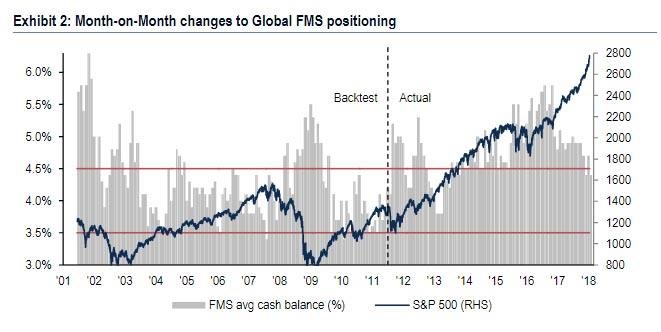
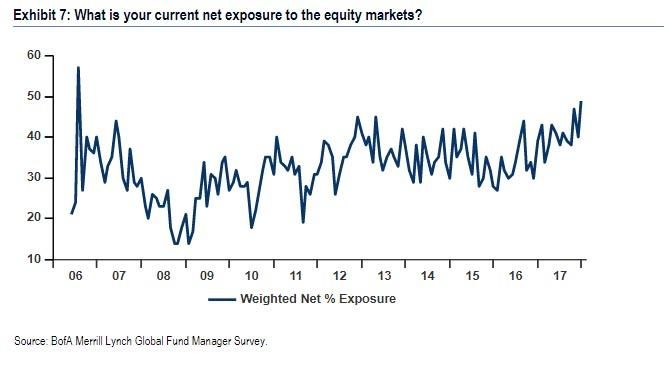
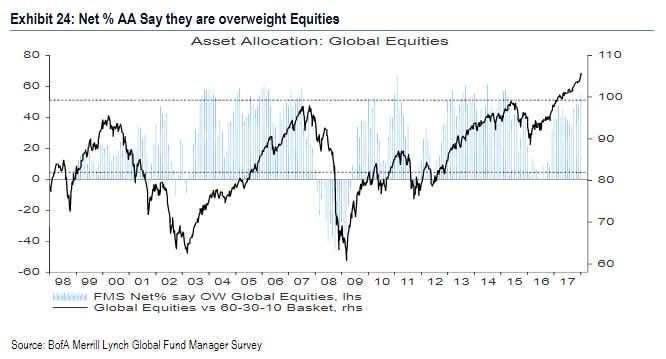
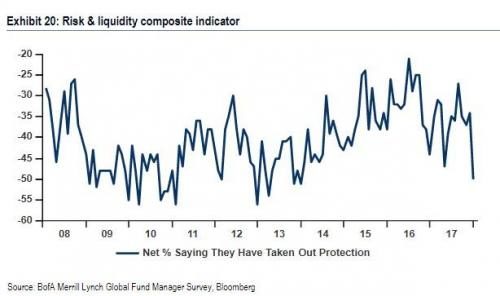
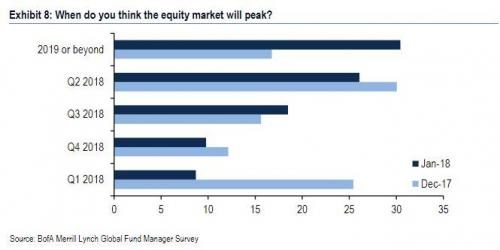
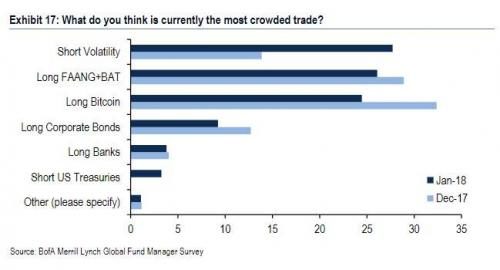
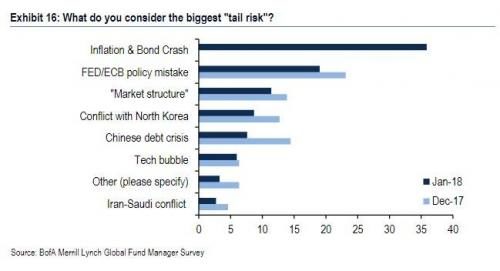
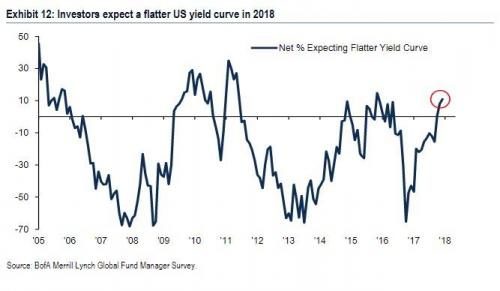
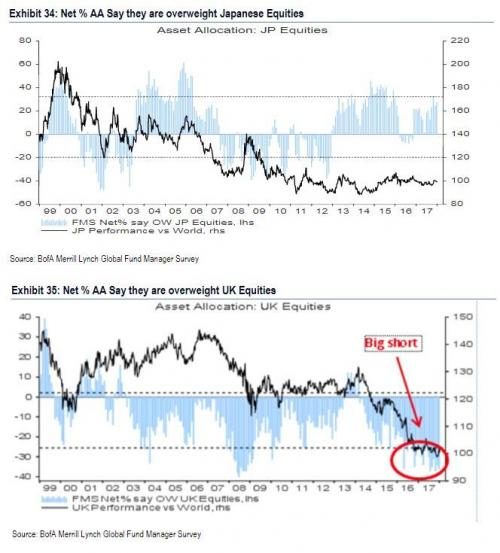
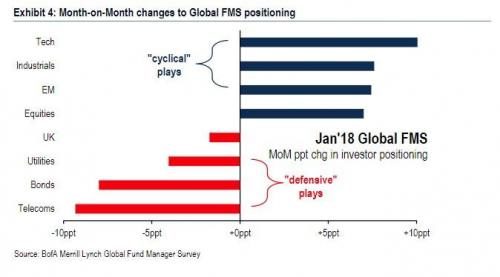
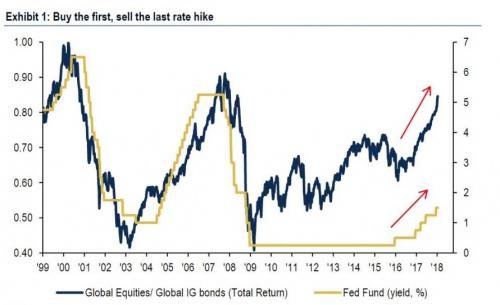



Chairperson of the Federal Reserve Janet Yellen warned on Thursday that the stock market is suffering from "irrational optimism" due to Russian hacking of the Facebook pages of dozens of investors, thereby influencing them to drive the Dow Jones average to ever-new highs. "This is a dangerous and possibly illegal game Putin is playing," she warned, adding that " t is also calculated to end the world and make Putin the new Tsar of not only Russia, but of America as well." In an interview with the New York Times, Yellen declared that "America got rid of King George in 1776. If Putin thinks he is going to be America's Tsar, he should just remember how much money the Federal Reserve can print to finance America;s wars, and remember who won World War II and every other war ever fought anywhere in the world."